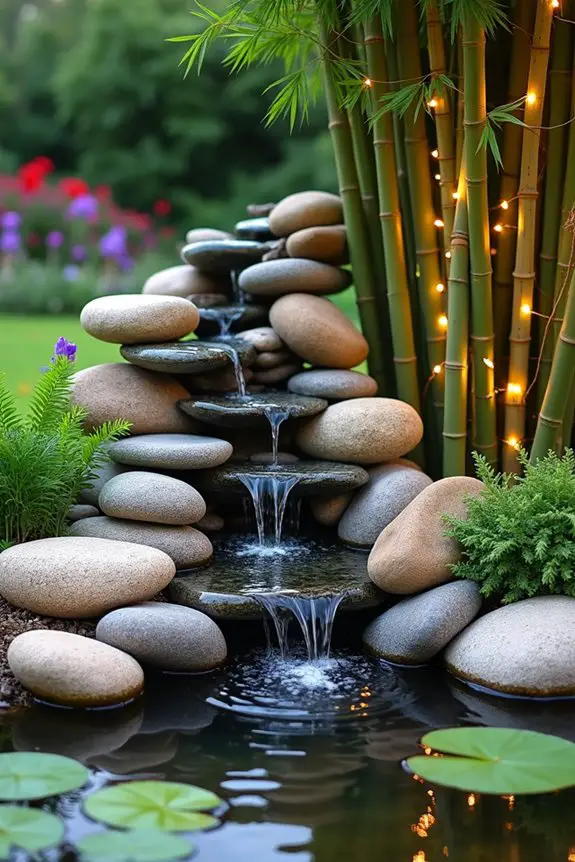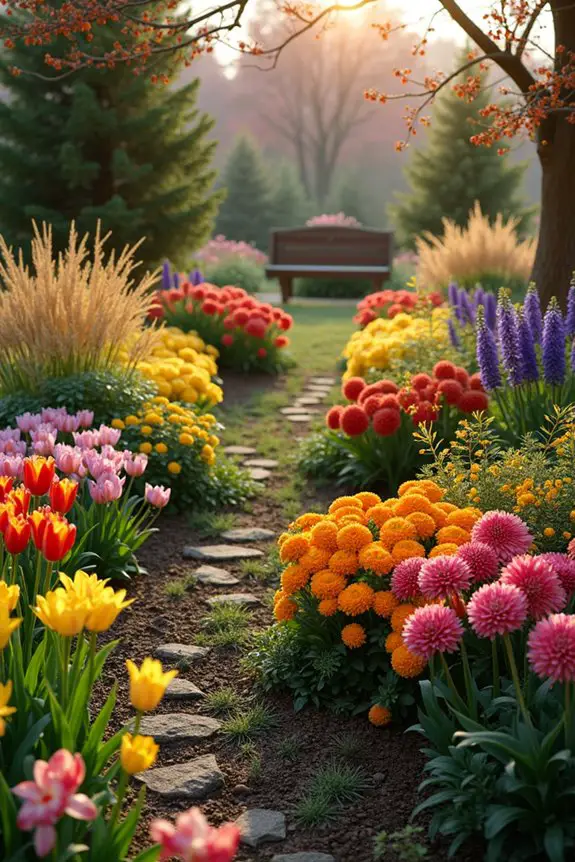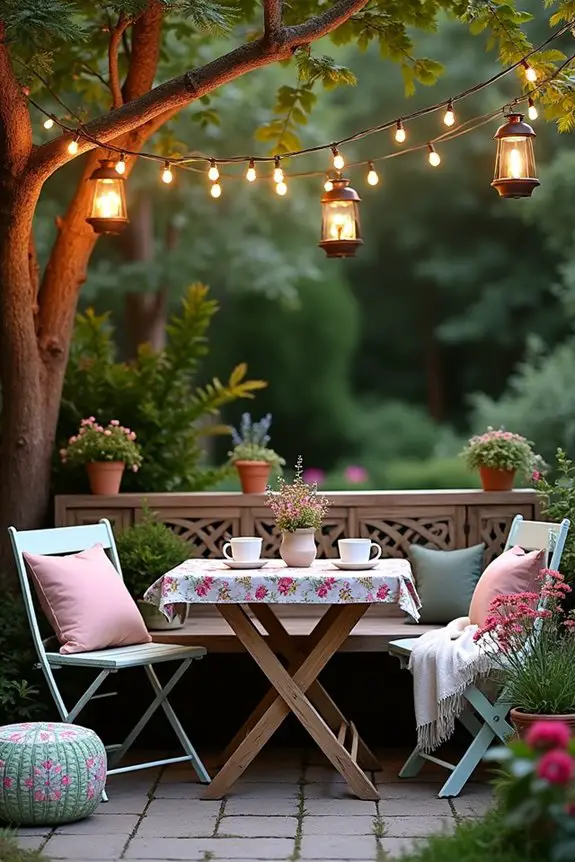Imagine walking into a garden filled with cascading plants, colorful terracotta pots, and twinkling fairy lights—it feels like stepping into an enchanting fairy tale, right? You’ve got the chance to make your own outdoor space just as magical. What if you could turn that empty corner into a vertical garden or a cozy nook with whimsical furniture? Stick around, because I’m about to share ten creative ideas that’ll bring your garden to life and leave your friends in awe.
Natural Material Inspired Designs
When you think about garden decor, natural materials can really make the space sing, don’t you think?
From wooden trellises that frame your favorite blooms to colorful containers that pop against the greenery, the possibilities are endless.
You can create a cozy garden path or even a vertical oasis on your wall—all while adding a touch of nature’s charm.
1. Wooden Trellis Garden Structures
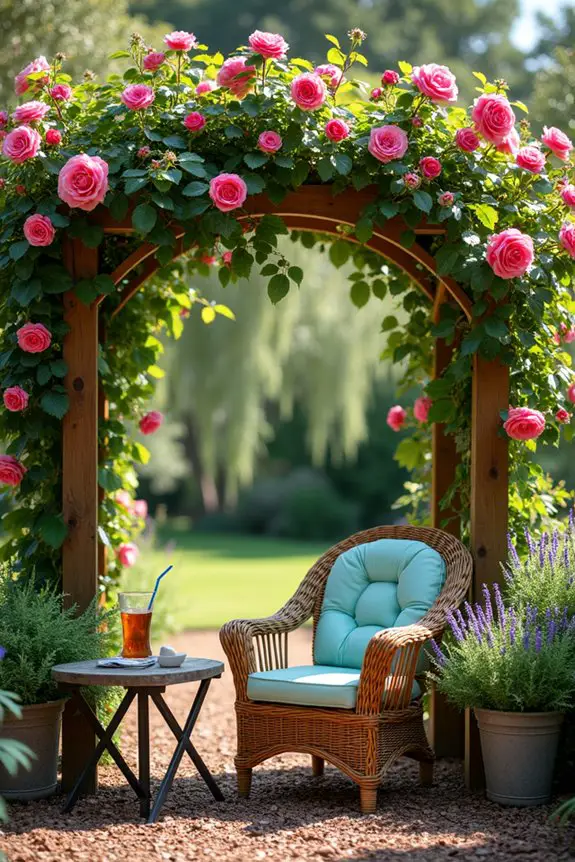
When it comes to garden decor, wooden trellis structures are just the ticket. Not only do they provide practical support for climbing plants, but they also add a rustic charm that can elevate the overall vibe of your space. Envision this: a cozy garden nook, with wild vines weaving through a beautifully crafted trellis – sounds dreamy, right?
First things first, decide where you want to place your trellis. Is it in a sunny spot or nestled in partial shade? The location determines what plants will thrive. If I’d a nickel for every time I planted something in the wrong spot, well, let’s just say I’d have a very nice garden setup by now.
Next, choose your wood wisely. Cedar and redwood are fantastic choices; they’ve got natural resistance to weather, so they’ll last longer. Plus, the warm hues just look stunning. If you’re feeling crafty, you could even make your own trellis. Just grab some wooden slats, a saw, and a little bit of elbow grease.
And no worries if you’re not a DIY pro. Even a simple rectangular design can look elegant with climbing roses or jasmine twining around it.
Once your trellis is up, it’s time to plant! Consider adding some fast-growing climbers like sweet peas or morning glory. The best part? These plants won’t only fill out your trellis, but they’ll also create a magical little hideaway as they flourish. You might even catch yourself sneakily sipping iced tea under your makeshift garden shade.
Lastly, don’t forget about maintenance. A little pruning goes a long way to keep things tidy. It’s like a haircut for your plants, and boy, can they get unruly if you don’t keep an eye on them. So, grab those pruners and get to snipping.
Your trellis will thank you, along with any guests who stop by to admire your handiwork.
With a wooden trellis, you’re not just adding structure; you’re creating a woven tapestry of nature and art. It’s all about establishing a spot where you can connect with nature, reflect, and—if you lean into it—give your friends a reason to be a bit envious of your green thumb.
2. Garden Pathway Layout Ideas
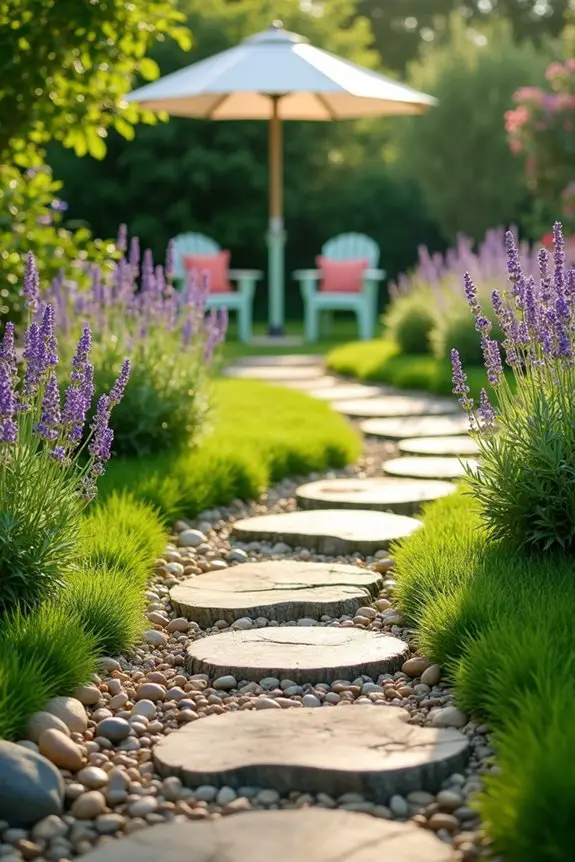
When you’re dreaming about a garden pathway, think of it as a welcoming hug for your flowers and plants. Not only does a well-designed path guide visitors through your green haven, but it also helps prevent soil compaction and keeps the mud at bay when things get a little soggy. Picture smooth stones, splashes of gravel, or even rustic wooden planks guiding the way—each option lending its charm while serving a purpose. Additionally, using tomato grow bags can help keep the integrity of your soil while growing delicious tomatoes alongside your pathway.
Starting with materials, consider using pebbles or stepping stones; just imagine those little gems nestled in a bed of lush greenery. It’s like a treasure hunt for your feet with each step! If you live somewhere where those stones are free to roam, I say—collect ’em! Just make sure to wear gloves unless you’re okay with looking like a mud pie.
Another cool idea is to use wood slabs for a more earthy feel, creating that woodland walk vibe right in your backyard. You just need to cut some sturdy slices of treated wood and place them about a foot apart. This setup not only looks natural, but it can also act like a cool, outdoor adventure path for kiddos (or adults who are young at heart).
Don’t forget to think about the path’s layout too. A winding pathway adds mystery and charm; it invites your guests to explore. Straight paths may seem practical, but come on, where’s the adventure in that? Plus, planting fragrant herbs like lavender or mint along the edges will give your pathway a delightful aroma, tickling the noses of anyone who strolls by. Trust me, it’s a sensory journey you don’t want to miss.
And as you’re laying out your path, consider a little elevation in spots. Slight inclines or curves can create visual interest, making your garden look layered and full of life, much like a good book with unexpected plot twists. Just watch your step, or you may find yourself in an argument with a stubborn rock—those things can be feisty.
To enhance your outdoor experience, consider incorporating a stylish garden parasol that can provide shade while you enjoy your beautifully crafted pathway.
In the end, a thoughtfully designed garden pathway isn’t just about getting from point A to point B; it’s about creating a journey that feels personal and inviting. So trust your instincts, play around with materials, and have fun with it. You’re crafting an experience. Sounds like a blast, right? Plus, you’ll finally have a reason to pull those old sneakers from the back of the closet.
3. Vertical Garden Wall Ideas
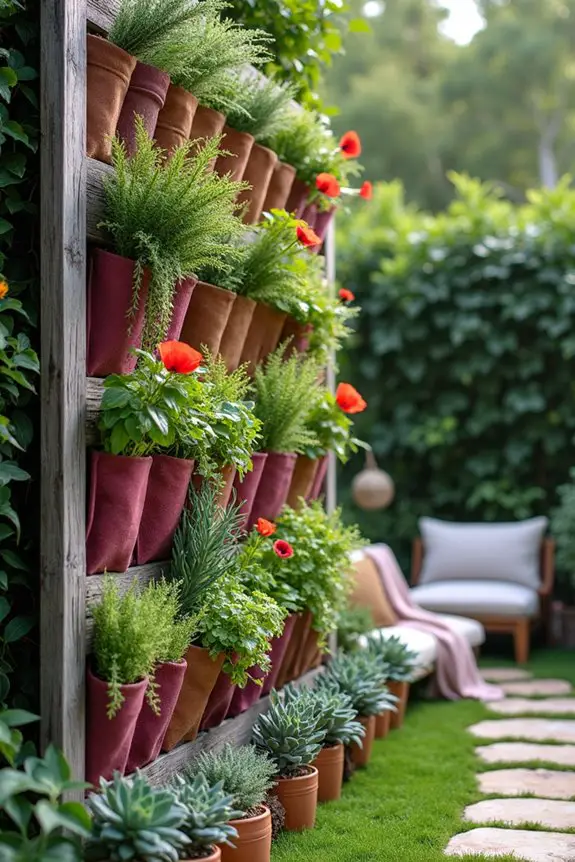
Vertical gardening can be a game changer in small spaces or for those wanting to add a bit of flair to their outdoor decor.
Envision lush greenery climbing up a wall, creating a living tapestry that’s as functional as it’s beautiful. Not only does it make use of vertical space, but it also adds depth and interest to your garden, almost like a magical beanstalk leading you to your very own horticultural wonderland.
Now, let’s talk about materials. Reclaimed wood is a fantastic option for building vertical garden walls. It’s rustic, eco-friendly, and tells a story—you know, like that friend who always shows up with great tales from their travels.
You can easily create a simple frame and attach planters or pockets made from burlap or fabric. This can be a fun weekend project. Just envision: you, your favorite tunes in the background, and sunshine on your face while you assemble your beautiful green masterpiece.
A great tip when designing your vertical garden wall is to mix and match plant types. Consider trailing vines, vibrant flowers, and even fresh herbs all coexisting in harmony; it’s like throwing a party where everyone appreciates each other’s quirks.
You may want to think about sturdy plants that are well-suited for vertical growth—like succulents or ivy. Oh, and don’t forget to complement them with some eye-catching pots. Just be careful not to get too carried away; trust me, trying to manage fourteen types of plants at once can lead to a chaotic green jungle.
Always remember to incorporate watering solutions. A drip irrigation system or self-watering pots can save your sanity (and time) while ensuring your plants stay hydrated.
I once found myself carrying buckets of water from the kitchen—let’s just say it was less than graceful, and my slippers are still recovering from that soggy adventure.
A vertical garden can transform an ordinary wall into a vibrant focal point. Envision evening gatherings in your yard, the soft smell of flowers wafting through the air while twinkling lights hang nearby.
With each new plant added, you’re not just cultivating greens; you’re creating your sanctuary. So grab those tools, free your inner gardener, and get ready to elevate your outdoor space in a gorgeous, green way.
It’s all about finding joy in the process, minus the armful of dirt.
4. Colorful Plant Container Designs
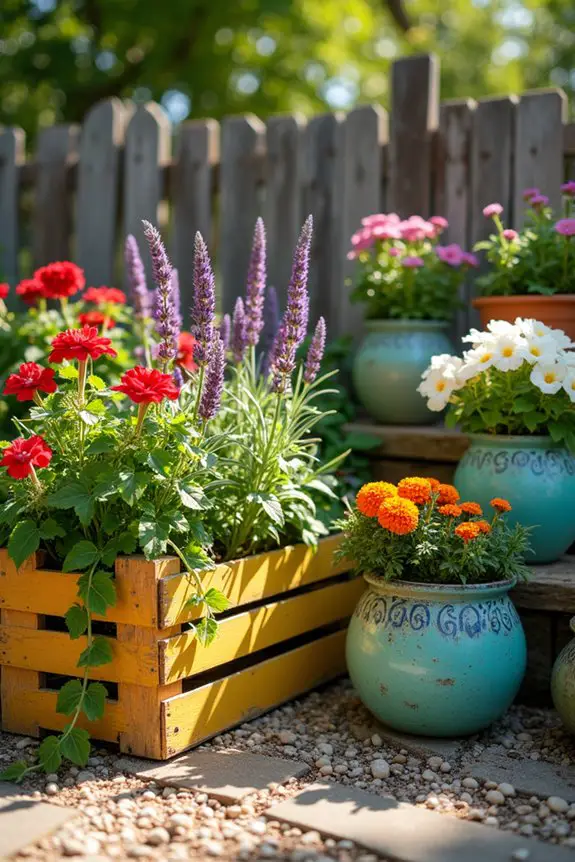
When it comes to adding a splash of personality to your garden, colorful plant containers inspired by natural materials can be a game-changer. Not only do these designs serve as beautiful vessels for your greenery, but they also create a harmonious vibe that ties your outdoor space together, inviting warmth and creativity. Imagine different textures and hues mingling, adding layers of interest to your garden sanctuary.
First things first, think about using materials like terracotta, wood, or even wicker. These choices aren’t only durable but also give off that earthy charm that makes you feel grounded (almost like you’re in the garden version of a cozy living room). You could upcycle an old wooden crate for a rustic planter. Just make sure to sand down any rough edges—trust me, splinters aren’t a welcome addition to your gardening adventure.
Next, let’s talk about color. Brighten things up with cheerful paint. Whether it’s a sunny yellow, calming blue, or vivid red, a fresh coat can make your containers pop. If you feel more artsy, try adding patterns or designs with stencils or sponges; it’s like giving those pots a personality of their own. I once painted my pots with flowers and then surprised myself when they ended up looking like a kindergarten art project gone rogue. But hey, imperfections can be charming (or so I tell myself).
Don’t forget about drainage. Good drainage is key to keeping those plants alive and thriving. Drill a few holes in the bottom of wood containers or choose porous options like terracotta that naturally allows water to escape. I learned this the hard way when I once excitedly set up a beautiful arrangement, only to find my plants swimming in an unexpected little lake after a rainstorm. It was a soggy affair and not the serene garden oasis I’d imagined.
When arranging your plants in these colorful containers, consider a mix of sizes and shapes. Think tall, bushy plants in the background and trailing varieties in the front—like layering a cake but, you know, with living organisms instead of frosting. Grouping containers together at varying heights can provide depth and drama. Just imagine it: a delightful, cohesive mini-garden that draws eyes and invites compliments from your neighbors (and perhaps a little envy).
In the end, colorful plant containers are the cherry on top of your garden sundae. They’re both practical for plant health and delightful for the heart. So go ahead, release your inner artist, and let those plants shine in a canvas that speaks to your style. Who knew gardening could be so much fun while also creating a space that feels like home? Adding a ceramic plant pots set can further enhance the vibrancy and charm of your garden decor.
5. Sculptural Plant Arrangement Design
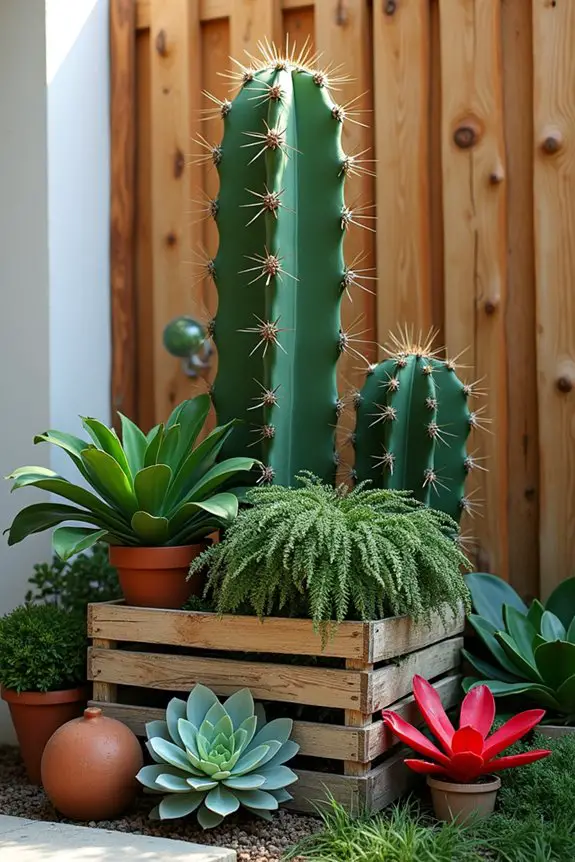
Creating sculptural plant arrangements in your garden is like putting on a fresh ensemble that turns heads—it’s all about making a statement while retaining function. By fusing unexpected elements, you can elevate your plants into art pieces. Plus, this design style brings in a beautiful blend of nature and creativity, encouraging a lovely dialogue between your greenery and its surroundings. Incorporating UV grow light sterilizers can also ensure that your plants stay healthy while enhancing their visual appeal.
Start by choosing your primary plants with shapes and textures that stand out. Think of spiky succulents, soft ferns, or cascading vines. The goal here is to create layers, so don’t shy away from using variations in height and scale. A tall, stately plant may serve as the centerpiece, while smaller accents join in like supporting actors, adding depth to the scene.
My first attempt involved a cactus that was so tall it almost stole the show from everything else, but hey, sometimes you’ve got to embrace your inner drama queen.
Next, consider the arrangement. Try using natural elements like wooden crates or reclaimed stone as pedestals to add some height and dimension. You might place your tallest plant in a rustic wooden box, flanked by smaller varieties in terracotta pots. This not only enhances the visual appeal but also creates the illusion of a well-thought-out design, even if you might’ve decided on the fly (like I often do).
To further emphasize the sculptural aspect, think about color and contrast. Select plants with different hues that play off each other beautifully, perhaps a dark green plant next to a vibrant red one. The contrasts will guide the eye and create focal points throughout.
Just be careful not to go overboard; too many colors can feel more like a carnival than a serene escape.
Lastly, don’t forget about the backdrop. A neutral scheme works wonders—think natural wood fencing or even a simple trellis. This way, your sculptural creations will shine bright without clashing visually.
It’s like giving your plants their red carpet, allowing them to strut their stuff without distractions. Trust me, there’s nothing quite like gazing at your garden and feeling all the pride, realizing you’ve turned a bunch of plants into a lovely mini-exhibit. Additionally, incorporating design elements like a stone garden sundial can enhance the aesthetics while providing a timeless focal point.
6. Hanging Garden Art Installations
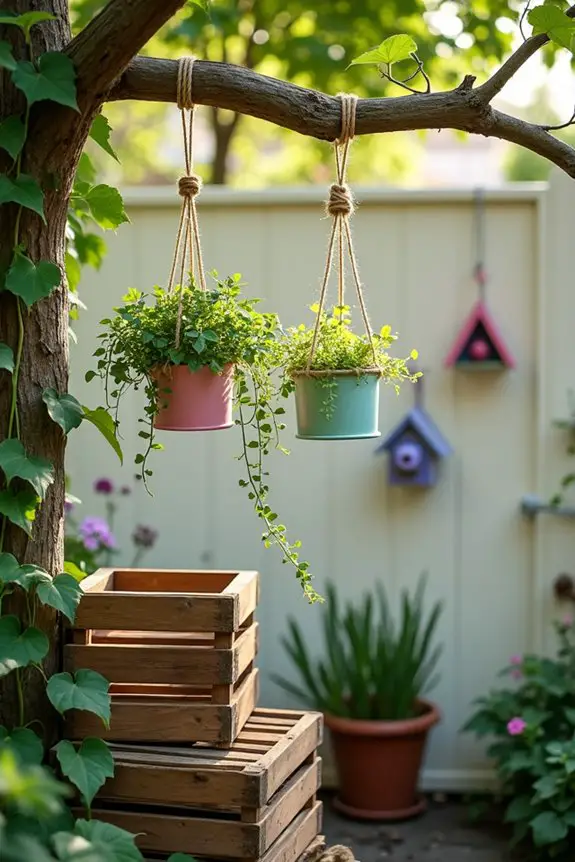
When it comes to adding some pizzazz to your garden, hanging garden art installations are a fantastic choice. Not only do they save on precious ground space, but they also create vertical visual interest that draws the eye upward, turning any drab corner into a mesmerizing focal point.
Plus, they can give your garden a whimsical, artistic vibe—like bringing a gallery of nature right into your backyard.
To get started with your own hanging garden art, think about incorporating natural materials like wood, metal, or even repurposed items. For instance, you could use old wooden crates or slices of tree trunks as stylish platforms for your plants.
Imagine plants draping down like nature’s version of a cascading curtain. It’s striking and creates an inviting atmosphere, as if your garden is inviting you to explore its secrets.
Next, consider the type of plants you want to showcase. Trailing plants, such as string-of-hearts or ivy, work beautifully in this format. They tumble gracefully, creating a soft, lush look that complements the rustic materials.
When I first hung my trailing ivy from a simple twig I found in my backyard, I was amazed at how quickly it transformed that dreary spot into a cozy nook. Who knew one little vine could make such a difference?
Also, think creatively about how to suspend your art. You could hang pots using twine or wire, or, to mix things up, use hooks to suspend quirky objects like birdhouses or decorated jars filled with soil.
They can act like little sculptures while hosting lovely plants. Just be sure to check the stability—trust me, you don’t want your artistic masterpiece (or your beloved plants) tumbling down unexpectedly.
Lastly, don’t ignore the background. If your hanging pieces are positioned against a bare wall or fence, add some paint or trellising to give them a richer context.
A splash of color or pattern can turn a simple hanging into the star of the show rather than just a supporting act. And don’t be afraid to layer things—the more dimension, the better!
With just a bit of creativity and effort, you can turn your garden into a visual feast that not only enhances the beauty of your plants but also reflects your unique artistic touch.
7. Rustic Stone Planter Design
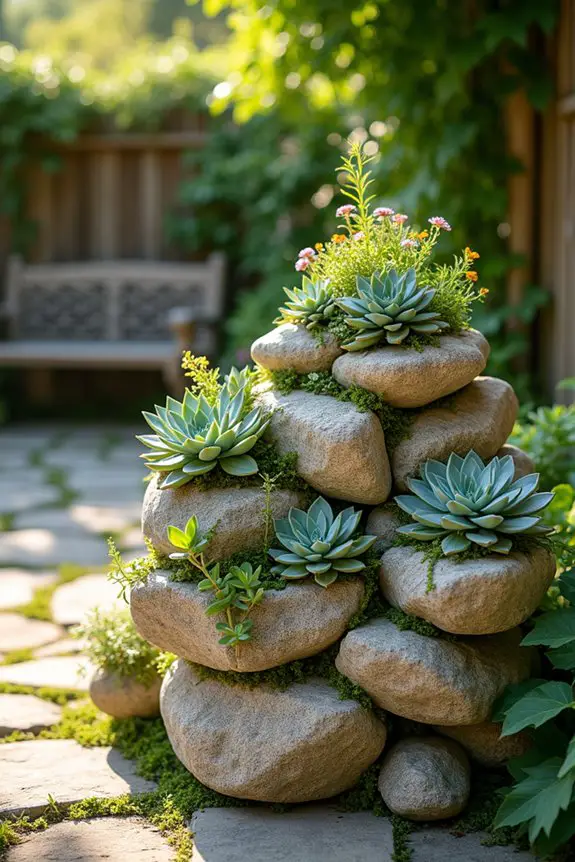
When you’re thinking about adding some earthy charm to your garden, rustic stone planters are a splendid choice. Not only do they offer a sturdy home for your blooms, but they also blend seamlessly with nature, enhancing the overall vibe of your outdoor space. It’s like giving your plants a cozy little hug from Mother Earth herself.
Imagine using natural stones, like river rocks or weathered limestone, to create planters that look like they’ve been in your garden for ages. You could even make it a fun DIY project. I once found a pile of uneven stones in my backyard, and after some brainstorming (and a little trial and error), I crafted a unique planter that has become a conversation starter among my friends.
The best part? It adds a rustic flair without breaking the bank—just a few stones, some potting soil, and your favorite flowers can work wonders.
Now, let’s talk about size and shape. Jobs like stacking flat stones to sculpt a planter can bring fun shapes into play, whether they’re low and wide or tall and narrow. Try to mix and match stones of different textures and sizes; it creates a beautiful mosaic effect that’s both eye-catching and rustic.
Just keep in mind (learned this the hard way), that your plants need proper drainage, so add some holes if you want them to thrive.
And don’t forget about the plants. Opt for hardy varieties that can handle the rocky environment, like succulents or hardy herbs. They just seem to thrive in a rustic stone setting, blending in beautifully. The last time I planted mini succulents in my stone planter, let’s just say, it turned into a flourishing green masterpiece that my neighbor still asks how I did it. Spoiler alert: I winged it.
Creating rustic stone planters isn’t just about aesthetics; it’s also about sustainability. You’re repurposing natural materials. That’s like giving Mother Earth a high-five.
8. Garden Lighting Design Ideas
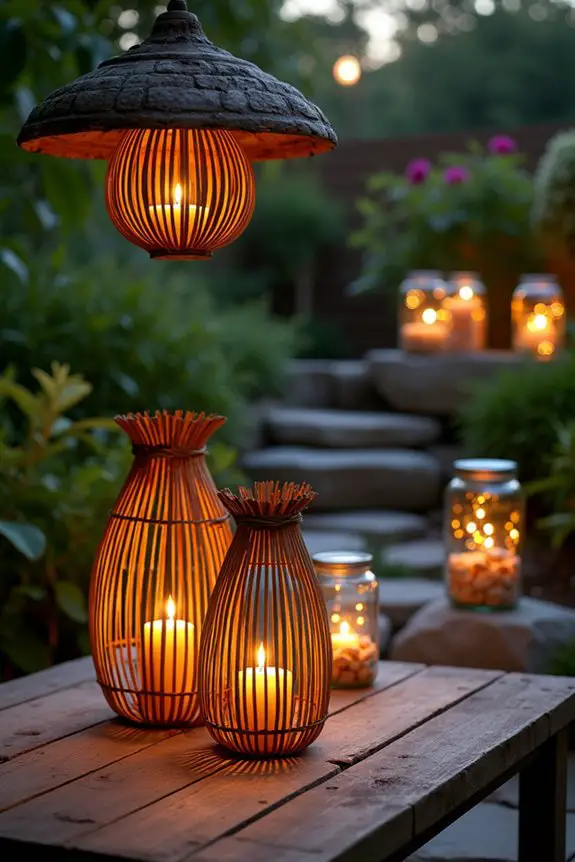
When it comes to garden lighting, using natural materials can transform your outdoor space into a magical retreat. Not only does it illuminate paths and seating areas, but it also complements the organic beauty of the garden. Mixing light with nature brings an intimate warmth, creating a cozy ambiance perfect for late-night chats or sipping tea under the stars.
One beautiful idea is to create lanterns using bamboo or reclaimed wood. Envision this: simple bamboo stalks fashioned into cylindrical lanterns, housing soft, flickering candles. The soft glow peeking through the bamboo slats adds whimsical charm, as if fireflies decided to stick around for a while. You can make these with a few tools, some string, and a little elbow grease (which we all know I could use more of). Just cut the bamboo to size, tie them together, and place a candle inside—a rustic masterpiece in minutes.
Feeling a bit more adventurous? How about using driftwood or logs to craft unique, outdoor light fixtures? Imagine casting warm light across a patio, with fixtures made from weathered pieces that look like they washed ashore from a beach adventure. Simply drill a hole big enough for a light socket, attach your fixture, and voilà, you’ve got a stunning focal point that echoes the beauty of nature.
Sure, you might end up with more glue on your hands than on the wood, and a few failed attempts are always a possibility, but the end result is totally worth it.
And let’s not forget about using stones or pebbles, too. Place fairy lights in mason jars filled with pebbles or small stones, and watch as it creates a dreamy, soft glow. It’s like bringing the magic of a starry night right to your garden.
Just remember to keep things organized (which is sometimes easier said than done)—otherwise, you’ll have a jumble of cords that could rival a spaghetti dinner.
9. Garden Furniture Arrangement Ideas
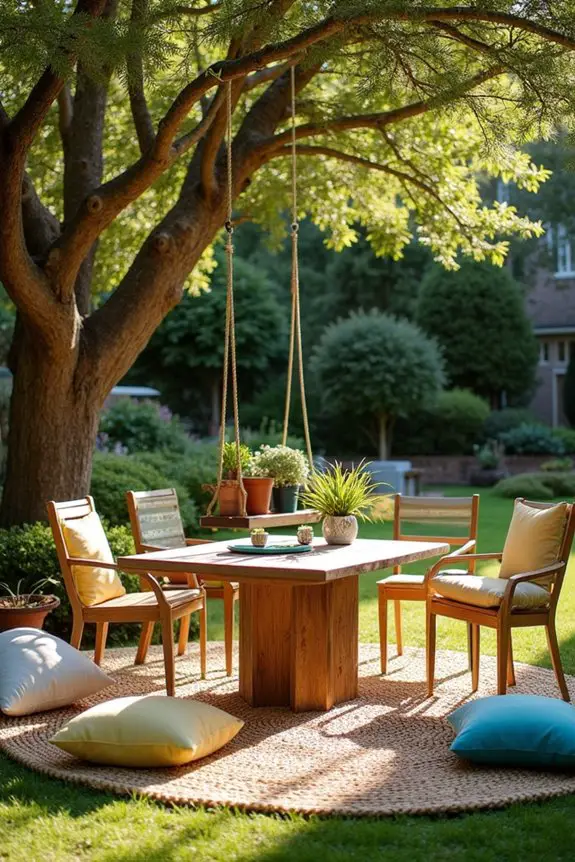
When it comes to creating a cozy garden setup, furniture arrangement can make all the difference. You want a space that’s not just functional but also feels inviting, like a warm hug on a chilly evening. Using natural materials adds an earthy charm that effortlessly blends with your garden’s beauty, creating a serene escape that’s perfect for relaxation or entertaining friends.
Start by choosing pieces that are crafted from woods like teak or cedar. These materials not only look stunning but also endure the elements quite well. Picture a lovely wooden table surrounded by mismatched chairs, each telling its own story. It’s a laid-back vibe, as if the garden itself decided, “Let’s keep this casual.”
Aim for a circular arrangement for dining. It encourages conversation and helps everyone feel part of the action. Plus, you can easily squeeze in a few extra chairs for those surprise guests—just hope they bring dessert.
For lounging, think about a natural fiber rug under a small seating area—a delightful nudge towards comfort. You could throw some plush cushions in cheerful colors to invite people to sink in and stay awhile. Just be careful, or you might find yourself snoozing in the sun instead of doing those pesky garden chores. Trust me, I’ve been there.
Choose durable fabric for your cushions, too, so you don’t end up replacing them every season (I’ve learned the hard way—hello, faded flowers).
Lastly, don’t underestimate the power of a little whimsy. Incorporate a swing made from reclaimed wood or hang some hanging chairs from sturdy branches. It’s like giving your garden a fun twist, creating spots for both laughter and leisurely afternoons.
Just make sure those branches are up for the challenge—I’m not saying I’ve hit the ground after misjudging a swing’s strength, but I’m also not denying it.
10. Water Feature Design Ideas
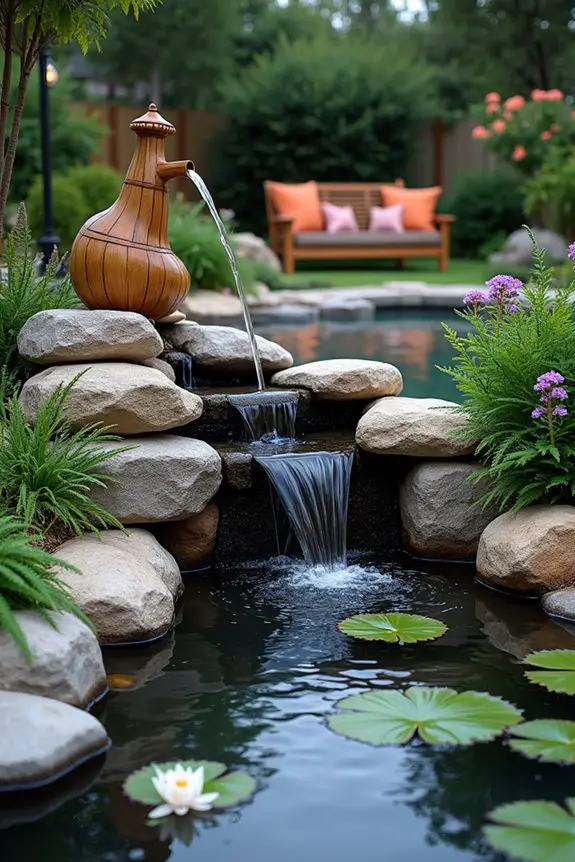
When it comes to transforming your garden into a serene retreat, one of the best ways to do it’s by incorporating a water feature.
Think about it: the gentle sound of water trickling, the shimmering light reflecting off the surface, it’s like nature’s own soundtrack. Not only does it add a beautiful element to your outdoor space, but it also invites relaxation and creates a cool vibe, perfect for sipping tea or having a chat with friends.
Let’s talk about natural materials for your water feature. You can’t go wrong with stone—whether it’s a small boulder or beautifully stacked flagstone, it offers a rustic charm.
Imagine a pond with smooth river rocks lining the edges, where water gently flows over them, creating a soft splash. It’s like Mother Nature herself is reminding you to take a deep breath and just chill out.
If you’re feeling a bit adventurous, why not build a DIY waterfall? It sounds complicated, but it’s easier than you might think.
Start with a sloped area in your yard, dig a little basin at the bottom, and use stone or gravel to create the waterfall’s path. This not only looks stunning but also offers your plants a much-needed nook of hydration. Just remember to check the water source; nobody enjoys a dry waterfall. Trust me, I learned that the hard way.
You could even incorporate some bamboo or wooden accents for a more Zen-like feel. A bamboo water spout trickling into a small pond pairs beautifully with water lily pads floating serenely on the surface.
Honestly, it’s like something out of a tranquil painting. Just make sure the bamboo is treated, so it withstands the elements.
And if you want to take it up a notch, consider adding lights around your water feature.
Soft, warm lights reflect off the water, transforming it into a magical oasis at night. Picture yourself enjoying a warm evening outside, the lights twinkling and the water glowing ever-so-slightly. Sounds dreamy, right?
Budget-Friendly DIY Projects
Why spend a fortune on garden decor when you can create stunning pieces for just a few bucks?
Think outside the box with these budget-friendly DIY projects. You could turn old mason jars into charming lanterns by adding tealights, or paint some wooden pallets for a rustic vertical garden.
How about upcycling tin cans? Just add a coat of color and plant herbs—instant garden decor that even a black thumb can handle.
Got an old bicycle? Prop it up and fill the basket with flowers for a whimsical touch.
These garden decor ideas not only sprout creativity but also save cash. Who knew making your garden fabulous could be this affordable?

